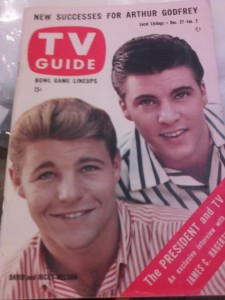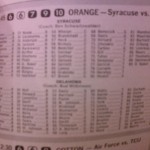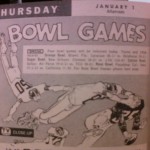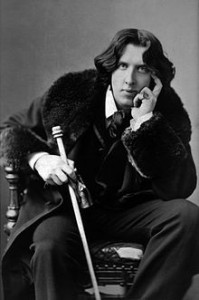They were up near the cash register in a small wire rack. For fifteen cents, you got TV listings for the entire week, gossip about your favorite stars of the small screen, and a crossword puzzle to boot.
TV Guide.
In my earlier years, I was a TV Guide, of sorts. I did voicework for Prevue Guide Network, which later bought the magazine and became the TV Guide Channel. I did the same sort of things as the magazine – letting you know about the movies on HBO and the network primetime shows – although I didn’t offer a crossword and could rarely be picked up at the checkout stand. (There were days, though…)
When folks learn I’m interested in old books, many figure I’m interested in any sort of old thing. It’s true, I guess, to some extent. I don’t collect TV Guide magazines, but someone obviously did. Now they’re in the bookstore in plastic bags.
Many of them are dated, even for me. The cover in the image dates to New Year’s Day 1959 and while I recall the TV show Ozzie and Harriet, I don’t remember much about the program or the sons, except Ricky. About a decade after this magazine came out, he had a hit song with Garden Party, a sarcastic tune that he wrote in response to being asked to play all his older songs in concert. It was a Madison Square Garden party, and his final lines in the song described his conclusion that “you can’t please everyone…you’ve got to please yourself.”
I’ve been pleasing myself with this pile of magazines. I should be tending to the stacks of books that need to be shelved, but there are a lot of fond recollections on the covers of these vintage TV Guides. (Vintage is what we call items dating back more than a few years, so we don’t feel ancient describing them as ‘Old’…which they are.)
The cover subjects (for those of you who are not – old) were the sons of Ozzie and Harriet Nelson. As best I can recall, they were a typical family but had all sorts of run-ins and situations that America found entertaining. Perhaps a bit like Seinfeld, without the racy innuendo. The article in the magazine shoots that down though:
The average family next door does not consist of a couple of parents who have worked and starred together in show business for most of their adult lives, and a couple of boys each worth a conservative quarter of a million dollars on the current market.”
The inflation calculator says “What cost $250,000 in 1959 would cost $1,902,240.51 in 2011,” pointing out the validity of the writer’s statement. Most of us kids of that day weren’t worth a couple of Billion. Most kids of today aren’t either, even adjusted for inflation.
Those were simpler times. The Big12 was a simple Big7 back then (adjusted for inflation… Actually, OSU – known as Oklahoma A&M in that era – had not yet joined the conference that became the Big8 and later the Big12). Bud Wilkinson coached the Sooners to a 10-1 record, losing only to Texas. OU was rewarded with an Orange Bowl invitation, where they played on New Year’s Day and whipped Syracuse 21-7.
There weren’t as many bowl games in that era, but they all got attention. The Rose Bowl parade was an event in 1959, and kids gathered round in front of the television to watch the spectacle. An actor named Ronald Reagan did the on-camera commentary that year on ABC, describing the floats and marching bands as they passed by.
He later got a job in Washington DC and did some on-camera work there, too.
I’m almost embarrassed to admit that I recognize the artist behind the flying football players on the facing page and included in the image. The style is known to many who thumbed through magazine pages in the sixties and seventies. His name was Jack Davis and he did a lot of commercial artwork. I’m not sure I ever saw his drawings in TV Guide before today.
But I saw them all the time as a kid growing up reading Mad Magazine.




